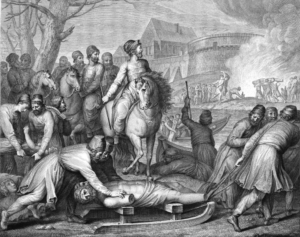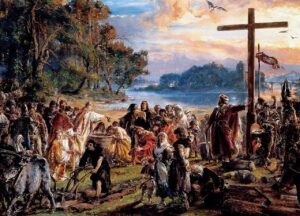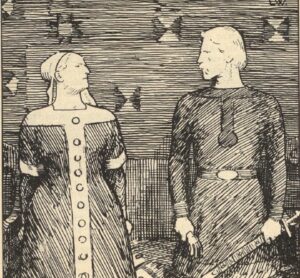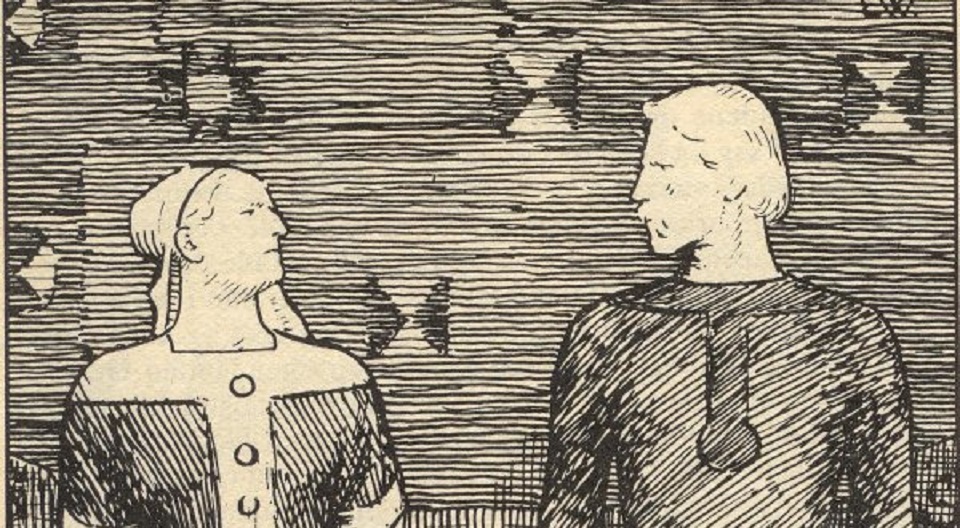One of the more prominent figures of early Polish history is Świętosława, also known as Sigrid the Haughty (Storråda). This daughter of Mieszko I made her mark mainly in the history of the countries on the other side of the Baltic Sea, being the wife of the kings of Sweden and Denmark, and the mother of the most powerful Scandinavian ruler of the Middle Ages, as the sagas described her. However, to what extent is such a portrait of her a reflection of reality, and to what is it a construct created by successive generations of historians?
by Michał Beczek
The small number and laconic nature of source accounts from the beginnings of the Polish state make this period a fertile ground for historiography to develop bold and often controversial theories. The biographies of the rulers and commanders of the time are often constructed from a considerable number of hypotheses based on a fragile source framework. It is, therefore, not surprising that, over many centuries, certain historical figures have been rediscovered or the existence of others, previously taken for granted, denied. This happened to the alleged ruler of Poland Bolesław, referred to as the Forgotten. The same is true of the heroine – or heroines – of this article, whose biography, repeatedly modified by historians on both sides of the Baltic Sea, will be examined in this text.
The basic information is provided by the chronicler Thietmar of Merseburg, invaluable for the study of the beginnings of the Polish state. He writes that the wife of Sweyn (who reigned from 987 to 1014), as well as the mother of the future kings of Denmark and England – Harald and Canute the Great – was the daughter of Mieszko I and sister of Bolesław the Brave. He also adds that she was (still without naming the character) finally exiled from Denmark by her husband. It was only after the death of Sweyn that his sons were to set out ‘to the land of the Slavs’, in order to fetch their mother. The biography of our (as yet) unnamed representative of the Piast dynasty is expanded by another source, the chronicle of Adam of Bremen. There we find information that Mieszko’s daughter came to Scandinavia as the wife of the ruler of Sweden, Eric the Victorious, and, only after the birth of his son Olaf and death of her husband circa 995, did she go to Denmark to marry the local king.

A figure with such a rich biography functioned without a name in historiography for a long time. In the Scandinavian sagas, Sweyn’s Slavic wife is preserved as Gunhilda, but the Germanic roots of the name have led most researchers to believe that the Piast princess adopted it during her stay in Denmark. A revolution in this respect was brought about by an analysis of the Anglo-Saxon source Liber vitae. Among the benefactors of the Winchester church of the time was the sister of Canute the Great, recorded as Santslaue, which the researchers reconstructed as ‘Świętosława’. It was then deduced that Sweyn’s daughter may have been named after her Slavic mother and, thus, the Piast queen of Sweden and Denmark became Świętosława.
Confusion in the resulting biography of Mieszko I’s daughter, however, is introduced by Old Scandinavian sagas. In them, we meet Sigrid the Haughty (Storråda), daughter of the Viking Skoglar Toste, whose biography is surprisingly similar to that of Świętosława. As the wife of Eric the Victorious, Sygryda bore him a son, Olaf, after which she was banished from Sweden by her husband, who ‘could not bear her haughtiness and pride’. She then attempted to win the heart of the Norwegian king, Olaf Tryggvason, but he, being a Christian, rejected the courtship due to Storråda’s attachment to the faith of her ancestors. The scorned woman swore revenge on him, which was the reason for Olaf’s downfall, since Storråda married the Danish Sweyn (following the death of his first wife, the Gunhild we already know of), and used her influence over her husband and Swedish son to assemble a coalition against Norway, which led to Olaf’s defeat and death in 1000. The nickname Storråda was due to Sigrid’s character, which we would today euphemistically label ‘difficult’. A glaring expression of this was the burning alive of suitors, recorded by the sagas, whom she deemed unworthy of her hand.

Similarities in the biographies of the two women led many Polish scholars to link their characters. In this way, the daughter of Mieszko I, Świętosława, known in Denmark as Gunhild, and described by the skálds as Sigrid, came into our historiography as the wife and mother of kings, a woman of irrepressible temperament, who influenced the political world of the Baltic region with her decisions. However, Scandinavian historians, as well as some Polish scholars, have been in opposition, believing there are insufficient grounds to merge the two figures into one.
The account of the marriage of Mieszko I’s daughter to Eric of Sweden has been questioned, pointing out that the only source providing information on this, i.e. Adam of Bremen, often gave misleading information on family relations in Scandinavian dynasties. On the other hand, all the sagas dealing with the topic of Eric’s marriage, indicate Sigrid Storråda as his wife, while remaining silent about her supposedly Slavic origin. It also appears unlikely that the newly baptised Mieszko would marry his daughter off to a ruler presented in sources as a fervent pagan. It is much easier to imagine Sigrid, the daughter of a maritime plunderer, professing the same faith at Eric’s side.

Analyses by Polish historian Rafał Prinke also dealt a severe blow to the name of our Piast heroine, which had hitherto been taken for granted. Namely, he has pointed out that Scandinavian tradition forbade naming children after living persons. As such, Canute’s sister Świętosława could not have had a mother with the same name. Similarly, Slavs also generally named their children after their grandparents, rather than their parents. This fits in with this assumption that Sweyn’s two granddaughters were named Gunhild – likely after their grandmother, who was no longer alive at the time of their births. The name Świętosława should therefore be taken away from Mieszko’s daughter and given to his mother. So what about the name of the heroine of this article? It appears that the best solution is to stick with the name Gunhild, known from the sagas. Contrary to appearances, it does not have to be a name adopted only at the court of her Danish husband. Indeed, the Baltic queen may have been Mieszko’s daughter by his second wife, the Saxon Oda of Haldensleben. In this case, Gunhild would have been named after her maternal grandmother.
How then should the question in the title of this article be answered? As with many issues concerning the early history of Poland, the most appropriate answer would be: ‘Given the number of source references from the period, it is impossible to provide a categorical answer to this question’. It appears, however, that the concept of Świętosława ‘absorbing’ Gunhild and Sigrid the Haughty known from the sagas, which was created in the Polish historiography of the 20th century, is difficult to maintain. On the other hand, the existence of Gunhild, Mieszko’s daughter, wife of Sweyn, mother of Harald and Canute, and of Sigrid the Haughty, first the wife of Eric the Victorious and subsequently, after Gunhild’s death, of Sweyn, corresponds much better with the message of the sources. On the other hand, let us ‘baptise’ Świętosława, the mother of Mieszko I, the first historical ruler of Poland, who is still unknown to us by name.
Author: Michał Beczek
Translation: Mikołaj Sekrecki





